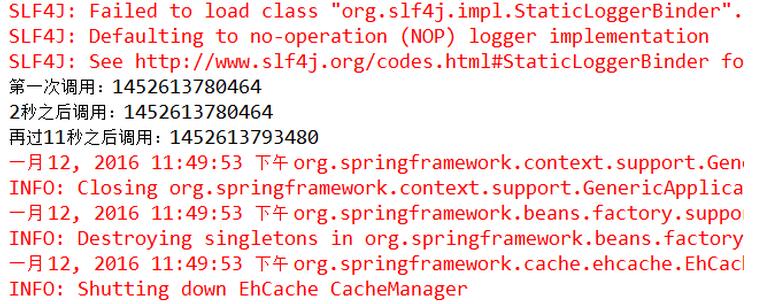一、ehcahe的介绍
EhCache 是一个纯Java的进程内缓存框架,具有高速、精干等特点,是Hibernate中默认的CacheProvider。Ehcache是一种广泛使用的开源Java分布式缓存。
主要面向通用缓存,Java EE和轻量级容器。
它具有内存和磁盘存储。缓存载入器,缓存扩展,缓存异常处理程序,一个gzip缓存servlet过滤器。支持REST和SOAP api等特点。
优点:
1. 高速
2. 简单
3. 多种缓存策略
4. 缓存数据有两级:内存和磁盘,因此无需操心容量问题
5. 缓存数据会在虚拟机重新启动的过程中写入磁盘
6. 能够通过RMI、可插入API等方式进行分布式缓存
7. 具有缓存和缓存管理器的侦听接口
8. 支持多缓存管理器实例,以及一个实例的多个缓存区域
9. 提供Hibernate的缓存实现
缺点:
1. 使用磁盘Cache的时候很占用磁盘空间:这是由于DiskCache的算法简单。该算法简单也导致Cache的效率很高。它仅仅是对元素直接追加存储。因此搜索元素的时候很的快。假设使用DiskCache的,在很频繁的应用中,很快磁盘会满。
2. 不能保证数据的安全:当突然kill掉java的时候,可能会产生冲突,EhCache的解决方法是假设文件冲突了。则重建cache。这对于Cache数据须要保存的时候可能不利。当然,Cache仅仅是简单的加速。而不能保证数据的安全。假设想保证数据的存储安全,能够使用Bekeley DB Java Edition版本号。
这是个嵌入式数据库。能够确保存储安全和空间的利用率。
EhCache的分布式缓存有传统的RMI,1.5版的JGroups,1.6版的JMS。分布式缓存主要解决集群环境中不同的server间的数据的同步问题。
使用Spring的AOP进行整合,能够灵活的对方法的返回结果对象进行缓存。
以下将介绍Spring+EhCache具体实例。
二、具体实例解说
本实例的环境 eclipse + maven + spring + ehcache + junit
2.1、相关依赖pom.xml
|
1
2
3
4
5
6
7
8
9
10
11
12
13
14
15
16
17
18
19
20
21
22
23
24
25
26
27
28
29
30
31
32
33
34
35
36
37
38
39
40
41
42
43
44
45
46
47
48
49
50
51
52
53
54
55
56
57
58
59
60
61
62
63
64
65
66
67
68
69
70
71
72
73
74
75
76
77
78
79
80
81
82
83
84
|
<project xmlns="http://maven.apache.org/POM/4.0.0" xmlns:xsi="http://www.w3.org/2001/XMLSchema-instance" xsi:schemaLocation="http://maven.apache.org/POM/4.0.0 http://maven.apache.org/xsd/maven-4.0.0.xsd"> <modelVersion>4.0.0</modelVersion> <groupId>com.luo</groupId> <artifactId>ehcache_project</artifactId> <version>0.0.1-SNAPSHOT</version> <properties> <!-- spring版本号号 --> <spring.version>3.2.8.RELEASE</spring.version> <!-- junit版本号号 --> <junit.version>4.10</junit.version> </properties> <dependencies> <!-- 加入Spring依赖 --> <dependency> <groupId>org.springframework</groupId> <artifactId>spring-core</artifactId> <version>${spring.version}</version> </dependency> <dependency> <groupId>org.springframework</groupId> <artifactId>spring-webmvc</artifactId> <version>${spring.version}</version> </dependency> <dependency> <groupId>org.springframework</groupId> <artifactId>spring-context</artifactId> <version>${spring.version}</version> </dependency> <dependency> <groupId>org.springframework</groupId> <artifactId>spring-context-support</artifactId> <version>${spring.version}</version> </dependency> <dependency> <groupId>org.springframework</groupId> <artifactId>spring-aop</artifactId> <version>${spring.version}</version> </dependency> <dependency> <groupId>org.springframework</groupId> <artifactId>spring-aspects</artifactId> <version>${spring.version}</version> </dependency> <dependency> <groupId>org.springframework</groupId> <artifactId>spring-tx</artifactId> <version>${spring.version}</version> </dependency> <dependency> <groupId>org.springframework</groupId> <artifactId>spring-jdbc</artifactId> <version>${spring.version}</version> </dependency> <dependency> <groupId>org.springframework</groupId> <artifactId>spring-web</artifactId> <version>${spring.version}</version> </dependency> <!--单元測试依赖 --> <dependency> <groupId>junit</groupId> <artifactId>junit</artifactId> <version>${junit.version}</version> <scope>test</scope> </dependency> <!--spring单元測试依赖 --> <dependency> <groupId>org.springframework</groupId> <artifactId>spring-test</artifactId> <version>${spring.version}</version> <scope>test</scope> </dependency> <!-- ehcache 相关依赖 --> <dependency> <groupId>net.sf.ehcache</groupId> <artifactId>ehcache</artifactId> <version>2.8.2</version> </dependency> </dependencies></project> |
2.2、加入ehcache配置文件ehcache-setting.xml
|
1
|
|
2
3
4
5
6
7
8
9
10
11
12
13
14
15
16
17
18
19
20
21
22
23
|
<?xml version="1.0" encoding="UTF-8"?><ehcache> <!-- 指定一个文件文件夹,当EhCache把数据写到硬盘上时。将把数据写到这个文件文件夹下 --> <diskStore path="java.io.tmpdir"/> <!-- 设定缓存的默认数据过期策略 --> <defaultCache maxElementsInMemory="10000" eternal="false" overflowToDisk="true" timeToIdleSeconds="10" timeToLiveSeconds="20" diskPersistent="false" diskExpiryThreadIntervalSeconds="120"/> <cache name="cacheTest" maxElementsInMemory="1000" eternal="false" overflowToDisk="true" timeToIdleSeconds="10" timeToLiveSeconds="20"/></ehcache> |
这里我们配置了cacheTest策略,10秒过期。
cache元素的属性:
name:缓存名称
maxElementsInMemory:内存中最大缓存对象数
maxElementsOnDisk:硬盘中最大缓存对象数。若是0表示无穷大
eternal:true表示对象永只是期,此时会忽略timeToIdleSeconds和timeToLiveSeconds属性。默觉得false
overflowToDisk:true表示当内存缓存的对象数目达到了
maxElementsInMemory界限后。会把溢出的对象写到硬盘缓存中。注意:假设缓存的对象要写入到硬盘中的话。则该对象必须实现了Serializable接口才行。
diskSpoolBufferSizeMB:磁盘缓存区大小,默觉得30MB。
每一个Cache都应该有自己的一个缓存区。
diskPersistent:是否缓存虚拟机重新启动期数据。是否持久化磁盘缓存,当这个属性的值为true时,系统在初始化时会在磁盘中查找文件名称为cache名称,后缀名为index的文件,这个文件里存放了已经持久化在磁盘中的cache的index,找到后会把cache载入到内存,要想把cache真正持久化到磁盘,敲代码时注意执行net.sf.ehcache.Cache.put(Element element)后要调用flush()方法。
diskExpiryThreadIntervalSeconds:磁盘失效线程执行时间间隔。默觉得120秒
timeToIdleSeconds: 设定同意对象处于空暇状态的最长时间,以秒为单位。当对象自从近期一次被訪问后,假设处于空暇状态的时间超过了timeToIdleSeconds属性值,这个对象就会过期,EHCache将把它从缓存中清空。仅仅有当eternal属性为false,该属性才有效。假设该属性值为0,则表示对象能够无限期地处于空暇状态
timeToLiveSeconds:设定对象同意存在于缓存中的最长时间,以秒为单位。
当对象自从被存放到缓存中后,假设处于缓存中的时间超过了 timeToLiveSeconds属性值,这个对象就会过期。EHCache将把它从缓存中清除。
仅仅有当eternal属性为false,该属性才有效。
假设该属性值为0,则表示对象能够无限期地存在于缓存中。
timeToLiveSeconds必须大于timeToIdleSeconds属性,才有意义
memoryStoreEvictionPolicy:当达到maxElementsInMemory限制时。Ehcache将会依据指定的策略去清理内存。可选策略有:LRU(近期最少使用,默认策略)、FIFO(先进先出)、LFU(最少訪问次数)。
2.3、spring配置文件application.xml
|
1
|
|
2
3
4
5
6
7
8
9
10
11
12
13
14
15
16
17
18
19
20
21
22
23
24
25
26
27
28
29
30
|
<?xml version="1.0" encoding="UTF-8"?><beans xmlns="http://www.springframework.org/schema/beans" xmlns:xsi="http://www.w3.org/2001/XMLSchema-instance" xmlns:cache="http://www.springframework.org/schema/cache" xmlns:context="http://www.springframework.org/schema/context" xmlns:aop="http://www.springframework.org/schema/aop" xsi:schemaLocation=" http://www.springframework.org/schema/beans http://www.springframework.org/schema/beans/spring-beans-3.0.xsd http://www.springframework.org/schema/aop http://www.springframework.org/schema/aop/spring-aop-3.0.xsd http://www.springframework.org/schema/context http://www.springframework.org/schema/context/spring-context-3.0.xsd http://www.springframework.org/schema/cache http://www.springframework.org/schema/cache/spring-cache-3.1.xsd"> <!-- 自己主动扫描注解的bean --> <context:component-scan base-package="com.luo.service" /> <cache:annotation-driven cache-manager="cacheManager" /> <bean id="cacheManager" class="org.springframework.cache.ehcache.EhCacheCacheManager"> <property name="cacheManager" ref="ehcache"></property> </bean> <bean id="ehcache" class="org.springframework.cache.ehcache.EhCacheManagerFactoryBean"> <property name="configLocation" value="classpath:ehcache-setting.xml"></property> </bean> </beans> |
2.4、EhCacheTestService接口
|
1
|
|
2
3
4
5
|
package com.luo.service;public interface EhCacheTestService { public String getTimestamp(String param);} |
2.5、EhCacheTestService接口实现
|
1
|
|
2
3
4
5
6
7
8
9
10
11
12
13
14
15
16
|
package com.luo.service.impl;import org.springframework.cache.annotation.Cacheable;import org.springframework.stereotype.Service;import com.luo.service.EhCacheTestService;@Servicepublic class EhCacheTestServiceImpl implements EhCacheTestService { @Cacheable(value="cacheTest",key="#param") public String getTimestamp(String param) { Long timestamp = System.currentTimeMillis(); return timestamp.toString(); }} |
这里注解中value=”cacheTest”与ehcache-setting.xml中的cache名称属性值一致。
2.6、单元測试类
|
1
|
|
2
3
4
5
6
7
8
9
10
11
12
13
14
|
package com.luo.baseTest;import org.junit.runner.RunWith; import org.springframework.test.context.ContextConfiguration; import org.springframework.test.context.junit4.AbstractJUnit4SpringContextTests; import org.springframework.test.context.junit4.SpringJUnit4ClassRunner; //指定bean注入的配置文件 @ContextConfiguration(locations = { "classpath:application.xml" }) //使用标准的JUnit @RunWith凝视来告诉JUnit使用Spring TestRunner @RunWith(SpringJUnit4ClassRunner.class) public class SpringTestCase extends AbstractJUnit4SpringContextTests {} |
|
1
|
|
2
3
4
5
6
7
8
9
10
11
12
13
14
15
16
17
18
19
20
21
|
package com.luo.service;import org.junit.Test;import org.springframework.beans.factory.annotation.Autowired;import com.luo.baseTest.SpringTestCase;public class EhCacheTestServiceTest extends SpringTestCase { @Autowired private EhCacheTestService ehCacheTestService; @Test public void getTimestampTest() throws InterruptedException{ System.out.println("第一次调用:" + ehCacheTestService.getTimestamp("param")); Thread.sleep(2000); System.out.println("2秒之后调用:" + ehCacheTestService.getTimestamp("param")); Thread.sleep(11000); System.out.println("再过11秒之后调用:" + ehCacheTestService.getTimestamp("param")); } } |
2.7、执行结果

三、工程源代码下载
以上就是本文的全部内容,希望对大家的学习有所帮助,也希望大家多多支持服务器之家。















